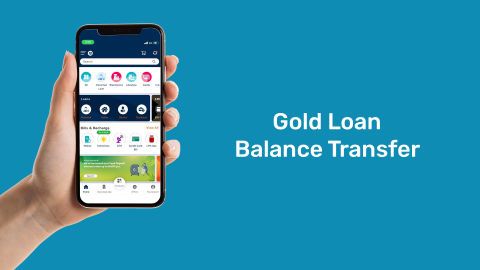2 mins
12 September 2024
A gold loan in India allows individuals to borrow money by pledging their gold jewellery as collateral. They are popular due to quick processing, multiple repayment options, and lower interest rates compared to unsecured loans.
Factors driving the gold loan market in India
Several factors have contributed to the rapid growth of the gold loan market in India. One primary driver is the cultural significance of gold, making it an essential asset for most Indian households. This asset provides instant liquidity during financial crises or emergencies. The rising gold price has also made it easier for borrowers to secure larger loans against their jewellery or gold assets. Another key factor is the growth of the informal economy, where many individuals seek loans without the need for complex documentation. Additionally, the increasing financial awareness among rural populations has led to a rise in demand for gold loans. Financial institutions have capitalised on this, offering easier repayment options, flexible terms, and attractive interest rates. Moreover, digitisation has enabled quicker loan disbursals, boosting accessibility for the masses.
Gold rates year-wise: A complete historical chart
India's gold prices have seen significant fluctuations over the years, influenced by global economic conditions, currency exchange rates, and domestic demand. In 2000, gold prices averaged around ₹4,400 per 10 grams, gradually rising in the following years due to economic growth and increasing inflation. By 2010, the price had surged to ₹18,500 per 10 grams as the global financial crisis drove investors towards safe-haven assets like gold. The price continued to rise, crossing ₹30,000 per 10 grams in 2013, owing to increased demand during the festive and wedding seasons. The highest spike came in 2020, when gold touched ₹56,000 per 10 grams during the COVID-19 pandemic, driven by economic uncertainty and a rush to invest in gold. A detailed year-wise chart provides insights into these trends, reflecting how external factors have shaped gold's value over time.Indian gold loan market size current and future
The Indian gold loan market has grown exponentially in recent years, with estimates suggesting a current market size exceeding ₹4 lakh crore. Banks, NBFCs, and fintech players dominate this space, offering short-term loans with gold as collateral. The increasing price of gold has led to a surge in the loan-to-value ratio, making gold loans an attractive option for borrowers. As more people look for quick liquidity without the hassle of extensive paperwork, the demand for gold loans continues to grow. The market is expected to expand at a compound annual growth rate (CAGR) of 15-18% in the coming years, driven by digital lending platforms, enhanced customer awareness, and innovative loan products. The future of the gold loan market in India looks promising, with financial institutions focusing on rural penetration and fintech integration.How the gold loan market in India has evolved?
Over the years, the Indian gold loan market has evolved from being an unorganised sector to a well-regulated and digitised financial service. Traditionally, people relied on local moneylenders for loans against their gold, often facing high interest rates and unfavourable terms. With the rise in gold price and the entry of banks and NBFCs, the gold loan market has become more formal and customer-friendly. Financial institutions now offer transparent pricing, standardised interest rates, and easy documentation processes, making gold loans accessible to a broader population. Digital advancements have also played a significant role in this transformation, with mobile apps and online platforms enabling instant loan approvals and disbursals. This shift has increased trust among borrowers and expanded the market's reach.The expanding gold loan market in India: opportunities and challenges
The expanding gold loan market in India presents numerous opportunities, particularly for financial institutions seeking to tap into the vast gold reserves held by Indian households. With gold prices on the rise and digital platforms making loan access easier, this market offers immense growth potential. The low default rates associated with gold loans make them an attractive proposition for lenders. However, challenges remain, including regulatory hurdles, fluctuating gold prices, and competition from other loan products. Moreover, rural penetration still requires significant effort, as many areas lack access to formal financial services. To seize these opportunities, lenders must focus on innovation, financial literacy, and customer-centric solutions while addressing the challenges of market saturation and fluctuating economic conditions.Regional insights into the gold loan market in India
- South India: Dominates the gold loan market, with a significant share due to cultural affinity for gold.
- North India: Experiencing growth, with more banks and NBFCs expanding gold loan services in rural areas.
- West India: Increasing demand driven by urban centres like Mumbai and Ahmedabad, where customers seek quick liquidity.
- East India: Slower growth, but potential exists due to the rising financial inclusion efforts.
- Rural vs Urban: Rural regions hold higher potential, with increased financial awareness and gold ownership; urban areas show growing demand for organised gold loan products.
The impact of gold prices on the gold loan market in India
- Loan-to-value ratio: Fluctuating gold prices directly impact the loan amount a borrower can secure.
- Demand: Higher gold prices tend to increase demand for gold loans as borrowers can access larger loans with the same collateral.
- Repayment: Volatile prices can affect borrowers’ ability to repay loans, leading to higher defaults during price drops.
- Interest rates: Gold price trends can influence the interest rates offered by lenders, with higher prices generally leading to more favourable rates.
- Market growth: Rising gold prices stimulate market growth, attracting more players and customers seeking to leverage their gold assets.
How big is the gold loan market in India?
- The gold loan market in India is one of the largest globally, estimated to be over ₹4 lakh crore in size.
- Gold loans constitute a significant portion of the overall lending portfolio for both banks and NBFCs.
- This market has grown rapidly due to India's cultural affinity for gold and the ease of obtaining loans with minimal documentation.
- The market is expected to grow at a double-digit CAGR, driven by rising gold prices and the increasing preference for gold-backed credit among individuals and small businesses.
- Lenders are focusing on expanding into rural areas, where gold ownership is higher, to tap into this lucrative market.
Analyzing the Indian gold loan market size over the years
- Early 2000s: The gold loan market was mostly unorganised, dominated by local lenders.
- 2010s: The sector saw a surge in growth due to the entry of NBFCs and the increasing gold market trends.
- COVID-19 era: Gold loans gained immense popularity as an immediate source of liquidity during the pandemic.
- Current size: Estimated to be over ₹4 lakh crore, with major players including banks, NBFCs, and fintech companies.
- Future projections: Expected to grow at a CAGR of 15-18%, driven by increasing gold prices, digital platforms, and expanding rural penetration.
Frequently asked questions
What is the history of gold prices in India?
The history of gold prices in India reflects a steady rise over the decades, influenced by economic conditions, global events, and demand. In the 1990s, gold was priced at around ₹3,200 per 10 grams. By 2008, during the global financial crisis, it surged to ₹12,000, and in 2020, due to the pandemic, it crossed ₹50,000 per 10 grams. Gold has consistently been a reliable investment, with its value increasing significantly over the years, making it a popular asset in India.
How can I find gold price history in India?
To find the gold price history in India, you can visit financial websites that track historical data, such as the Reserve Bank of India’s portal or commodity-specific platforms. Several online platforms also provide year-wise gold rate charts. You can also check reliable news portals that cover market trends. Additionally, financial apps and websites of major jewellers often offer historical gold price data, helping you track changes over the years and make informed investment decisions.
What is the highest price of gold in history?
The highest price of gold in history occurred in August 2020, when it reached approximately ₹56,200 per 10 grams in India. This surge was primarily driven by the global economic uncertainty caused by the COVID-19 pandemic, along with inflation fears and low interest rates. Investors flocked to gold as a safe-haven asset, pushing its price to unprecedented levels. Since then, gold has remained a popular investment, offering stability amidst ongoing economic fluctuations and geopolitical tensions worldwide.
What is the historical return of gold prices?
Historically, gold has provided steady returns over the long term, often acting as a hedge against inflation and economic uncertainty. In India, gold prices have risen from around ₹3,200 per 10 grams in 1990 to over ₹50,000 in 2020. This represents an average annual growth rate of around 10% over the past few decades. While short-term fluctuations occur, gold has consistently appreciated, making it a reliable investment for Indian investors seeking stability during volatile market conditions.
Show More
Show Less
Bajaj Finserv App for All Your Financial Needs and Goals
Trusted by 50 million+ customers in India, Bajaj Finserv App is a one-stop solution for all your financial needs and goals.
You can use the Bajaj Finserv App to:
Apply for loans online, such as Instant Personal Loan, Home Loan, Business Loan, Gold Loan, and more.
You can use the Bajaj Finserv App to:
Apply for loans online, such as Instant Personal Loan, Home Loan, Business Loan, Gold Loan, and more.
- Explore and apply for co-branded credit cards online.
- Invest in fixed deposits and mutual funds on the app.
- Choose from multiple insurance for your health, motor and even pocket insurance, from various insurance providers.
- Pay and manage your bills and recharges using the BBPS platform. Use Bajaj Pay and Bajaj Wallet for quick and simple money transfers and transactions.
- Apply for Insta EMI Card and get a pre-approved limit on the app. Explore over 1 million products on the app that can be purchased from a partner store on Easy EMIs.
- Shop from over 100+ brand partners that offer a diverse range of products and services.
- Use specialised tools like EMI calculators, SIP Calculators
- Check your credit score, download loan statements, and even get quick customer support—all on the app.






